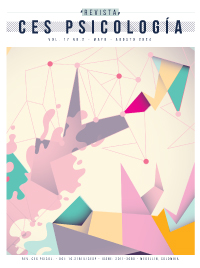Attachment to parents and problematic use of internet in young: The moderating effect of emotional regulation
DOI:
https://doi.org/10.21615/cesp.7142Keywords:
attachment, emotional regulation, internet, adolescents and young adultsAbstract
According to the attachment theory, individuals manifest an intrinsic need to establish affective bonds with the primary caring figures. Secure attachment to parents and management of emotional regulation may be a protective factor against the problematic use of the Internet. The main objective of this study was to analyze the effect of parents´ involvement in the development of adolescents and young adults' problematic use of the internet and test the moderator role of emotional regulation in this association. This is an empirical, cross-sectional study with a random sample. The sample comprised 936 students between 14 and 20 years old, male and female sex. The Father and Mother Attachment Questionnaire (QVPM, Matos & Costa, 2001), the Emotional Regulation Difficulties Scale (DERS Gratz & Roemer, 2004; adapted by Coutinho et al., 2010) and the Generalized Problematic Internet Use Scale 2 (GPIUS-2, Caplan, 2010; adapted by Pontes et al., 2016) were used as evaluation instruments and collected in person. Thus, it is understood that the frequency of excessive use of the internet, specifically social networks, as well as the lack of parental supervision in the use of the internet by their children, may be associated with Problematic Internet Use behaviors in adolescents and young adults.
Downloads
References
Ainsworth, M. (1969). Object relations, dependency, and attachment: theoretical review of the infant-mother relationship. Child Development, 40, 969-1026.
Akin, A. (2012). The relationships between Internet addiction, subjective vitality, and subjective happiness. Cyberpsychology, Behavior, and Social Networking, 15(8), 404-410. https://doi.org/10.1089/cyber.2011.0609
Arnett, J. (2007). Emerging adulthood: What is it, and what is it good for? Child Development Perspectives, 1, 68-73. https://doi.org/10.1111/j.1750-8606.2007.00016.x
Assunção, R. (2016). Facebook: novas formas de comunicação e adaptação psicossocial de adolescentes. (tese de doutoramento não publicada). Universidade do Porto- Faculdade de Psicologia e de Ciências da Educação, Porto.
Assunção, R., Costa, P., Tagliabue, S., & Matos, P. M. (2017). Problematic facebook use in adolescents: associations with parental attachment and alienation to peers. Journal of Child and Family Studies, 26(11), 2990-2998. https://doi.org/10.1007/s10826-017-0817-2.
Baumgartner, S., Valkenburg, P., & Peter, J. (2010). Assessing causality in the relationship between adolescents’ risky sexual online behavior and their perceptions of this behavior. Journal of Youth and Adolescence, 39, 1226–1239. https://doi.org/10.1007/s10964-010-9512-y.
Boniel-Nissim, M., & Sasson, H. (2018). Bullying victimization and poor relationships with parents as risk factors of problematic Internet use in adolescence. Computers in Human Behavior, 176-183. https://doi.org/10.1016/j.chb.2018.05.041
Bowlby, J. (1973). Attachment and loss. Vol.2: Separation, anxiety and anger. Basic Books.
Bowlby, J. (1988). A secure base: parent-child attachment and healthy human development. Basic Books.
Burén-J., & Lunde, C. (2018). Sexting among adolescents: a nuanced and gendered online challenge for young people. Computers in Human Behavior, 85, 210-217. https://doi.org/10.1016/j.chb.2018.01.003
Caplan, S. E. (2010). Theory and measurement of generalized problematic internet use: A two-step approach. Computers in Human Behavior, 26, 1089-1097. https://doi.org/10.1016/j.chb.2010.03.012
Correia, F., & Mota, C. P. (2016). Ambiente familiar e qualidade da vinculação amorosa: papel mediador da individuação em jovens adultos. Análise Psicológica, 34(1), 15-29. https://doi.org/10.14417/ap.1018
Coutinho, J., Ribeiro, E., Ferreirinha, R., & Dias, P. (2010). Versão portuguesa da Escala de Dificuldades de Regulação Emocional e sua relação com sintomas psicopatológicos. Revista de Psiquiatria Clínica, 37(4), 145-151.
Davis, R. A. (2001). A cognitive-behavioral model of pathological internet use. Computers in Human Behavior, 17(2), 187-195. https://doi.org/10.1016/S0747-5632(00)00041-8
Davis, R. A., Flett, G. L., & Besser, A. (2002). Validation of a new scale for measuring problematic internet use: implications for pre-employment screening. CyberPsychology & Behavior, 5(4), 331-345. https://doi.org/10.1089/109493102760275581
Del Giudice, M. (2019). Sex differences in attachment styles. Current opinion in psychology, 25, 1-5. https://doi.org/10.1016/j.copsyc.2018.02.004
Erikson, E. (1968). Identity: Youth and crisis. Norton.
Faria, H. C., Costa, I. P., & Neto, A. S. (2018). Hábitos de utilização das novas tecnologias em crianças e jovens. Gazeta Médica, 4 (5), 271-276.
Fleming, M. (2005). Entre o medo e o desejo de crescer: Psicologia da adolescência. Edições Afrontamento.
Gámez-Guadix, M., Orue, L., Smith, P., & Calvete, E. (2018). Longitudinal and reciprocal relationships of cyberbullying with depression, substance use, and problematic internet use among adolescents. Journal of Adolescent Health, 53(4), 446-452. https://doi.org/10.1016/j.jadohealth.2013.03.030
Gardener, E. K. T., Carr, A., MacGregor, A., & Felmingham, K. (2013). Sex differences and emotion regulation: an event-related potential study. Plos One, 8(10), 1-9. https://doi.org/10.1371/journal.pone.0073475
Gratz, K. L., & Roemer, L. (2004). Multidimensional assessment of emotion regulation and dysregulation. Development, factor structure, and initial validation of the difficulties in emotion regulation scale. Journal of psychopathology and behavioral assessment, 26(1), 41-54.
Henriques, B. M. (2014). Qualidade da vinculação e comportamento antissocial na infância. International Journal of Development and Educational Psychology, 1(1), 35-43. https://doi.org/10.17060/ijodaep.2014.n1.v4.591
Ho, S. S., Lwin, M. O., & Lee, E. W. (2017). Till logout do us part? Comparison of factors predicting excessive social network sites use and addiction between Singaporean adolescents and adults. Computers in Human Behavior, 75, 632-642. https://doi.org/10.1016/j.chb.2017.06.002.
Hormes, J., Kearns, B., & Timko, C. (2014). Craving Facebook? Behavioral addiction to online social networking and its association with emotion regulation deficits. Addiction, 9, 2079-2088. https://doi.org/10.1111/add.12713
Jenkins-Guarnieri, M. A., Wright, S. L., & Hudiburgh, L. M. (2012). The relationships among attachment style, personality traits, interpersonal competency, and Facebook use. Journal of Applied Developmental Psychology, 33(6), 294-301. https://psycnet.apa.org/doi/10.1016/j.appdev.2012.08.001
Kalaitzaki, A. E., & Birtchnell, J. (2014). The impact of early parenting bonding on young adults’ Internet addiction, through the mediation effects of negative relating to others and sadness. Addictive behaviors, 39(3), 733-736. https://doi.org/10.1016/j.addbeh.2013.12.002
Karaiskos, D., Tzavellas, E., Balta, G., & Paparrigopoulos, T. (2010). P02-232-Social network addiction: a new clinical disorder? European Psychiatry, 25, 855. https://doi.org/10.1016/S0924-9338(10)70846-4
Kayes, I., & Iamnitchi, A. (2017). Privacy and security in online social networks: A survey. Online Social Networks and Media, 3, 1-21. https://doi.org/10.1016/j.osnem.2017.09.001
Kim, H., & Davis, K. (2009). Toward a comprehensive theory of problematic Internet use: evaluating the role of self-esteem, anxiety, flow, and the self-rated importance of Internet activities. Computers in Human Behavior, 25, 490-500. https://doi.org/10.1016/j.chb.2008.11.001
Livingstone, S., Haddon, L., Gorzig, A., & Ólafsson, K. (2011). Risk and safety on the internet: the perspective of European children. Full findings. EU Kids Online, LSE.
Machado, T. S., & Pardal, A. (2013). Padrões adaptativos de aprendizagem e estratégias de regulação das emoções em adolescentes. Psicologia, Educação e Cultura, 17(2), 134-150.
Matos, P. M., & Costa, M. E. (2001). Questionário de vinculação ao pai e à mãe. Manuscrito não publicado. Faculdade de Psicologia e de Ciências da Educação da Universidade do Porto.
Matos, P. M., & Costa, M. E. (2006). Vinculação aos pais e ao par romântico em adolescentes. Psicologia, 20(1), 97-126.
Mazman, S. G., & Usluel, Y. K. (2011). Gender differences in using social networks. Turkish Online Journal of Educational Technology, 10(2), 133-139.
Meier, A. M., Carr, D. R., Currier, J. M., & Neimeyer, R. A. (2013). Attachment anxiety and avoidance in coping with bereavement: Two studies. Journal of Social and Clinical Psychology, 32(3), 315-334. https://psycnet.apa.org/doi/10.1521/jscp.2013.32.3.315
Monteiro, L., Veríssimo, M., Vaughn, B. E., Santos, A. J., & Fernandes, M. (2008). Análise do fenómeno de base segura em contexto familiar: As relações criança/mãe e criança/pai. Psicologia, 22(1), 104-25.
Moura, O., & Matos, P. M. (2008).Vinculação aos pais, divórcio e conflito interparental em adolescentes. Psicologia, 22(1), 127-152.
Nunes, F., & Mota, C. P. (2017). Vinculação aos pais, competências sociais e ideação suicida em adolescentes. Arquivos Brasileiros de Psicologia, 69(3), 52-65. http://pepsic.bvsalud.org/scielo.php?script=sci_arttext&pid=S1809-52672017000300005
Oldmeadow, J. A., Quinn, S., & Kowert, R. (2013). Attachment style, social skills, and Facebook use amongst adults. Computers in Human Behavior, 29, 1142-1149. https://doi.org/10.1016/j.chb.2012.10.006
Piguet, C., Berchtold, A., Akre, C., & Suris, J-C. (2015). What keeps female problematic internet users busy online? European Journal of Pediatrics, 1-7. https://doi.org/10.1007/s00431-015-2503-y
Pontes, H. M., Caplan, S. E., & Griffiths, M. D. (2016). Psychometric validation of the generalized problematic Internet use scale 2 in a Portuguese sample. Computers in Human Behavior, 63, 823-833. https://doi.org/10.1016/j.chb.2016.06.015.
Pontes, H. M., Patrão, I. M., & Griffiths, M. D. (2014). Portuguese validation of the Internet Addiction Test: an empirical study. Journal of Behavioral Addictions, 3(2), 107-114. https://doi.org/10.1556/JBA.3.2014.2.4
Rial, A., Gómez, P., Braña, T., & Varela, J. (2014). Actitudes, percepciones y uso de Internet y las redes sociales entre los adolescentes de la comunidad gallega (España). Anales de Psicología, 30(2), 642-655. https://doi.org/10.6018/analesps.30.2.159111
Richards, R., McGee, R., Williams, S. M., Welch, D., & Hancox, R. J. (2010). Adolescent screen time and attachment to parents and peers. Archives of Pediatrics & Adolescent Medicine, 164(3), 258-262. https://doi.org/10.1001/archpediatrics.2009.280.
Rücker, J., Akre, C., Berchtold, A., & Suris, J-C. (2015). Problematic internet use is associated with substance use in young adolescents. Acta Paediatrica. https://doi.org/10.1111/apa.12971
Sariyska, R., Reuter, M., Lachmann, B., & Montag, C. (2015). Attention deficit/hyperactivity disorder is a better predictor for problematic internet use than depression: evidence from Germany. Journal of Addiction Research & Therapy, 6(209). https://doi.org/10.4172/2155-6105.1000209
Silva Mendes, L., & da Luz Vale Dias, M. (2018). Estilos educativos parentais, confiança interpessoal e vinculação aos pais, pares e par amoroso: Sua relação numa amostra de adolescentes. Journal of Child & Adolescent Psychology/Revista de Psicologia da Criança e do Adolescente, 9(2), 27-42.
Smahel, D., Brown, B. B., & Blinka, L. (2012). Associations between online friendship and Internet addiction among adolescents and emerging adults. Development Psychology, 48(2), 381-388. https://doi.org/10.1037/a0027025
Soares, I., & Dias, P. (2007). Apego y psicopatología en jóvenes y adultos: contribuiciones recientes de la investigación. International Journal of Clinical and Health Psychology, 7(1), 177-195.
Tokunaga, R. S. (2015). Perspectives on internet addiction, problematic internet use, and deficient self-regulation: contributions of communication research. In E.L. Cohen (Ed.), Communication Yearbook 30 (pp. 131-161). Routledge.
Veríssimo, M., Fernandes, C., Santos, A., Peceguina, I., Vaughn, B., & Bost, K. (2012). A relação entre a qualidade da vinculação à mãe e o desenvolvimento da competência social em crianças de idade pré-escolar. Psicologia: Reflexão e Crítica, 24(2), 292-299.
Wegmann, E., Oberst, U., Stodt, B., & Brand, M. (2017). Online-specific fear of missing out and Internet-use expectancies contribute to symptoms of Internet-communication disorder. Addictive Behaviors Reports, 5, 33-42.
Weinstein, A., Dorani, D., Elhadif, R., Bukovza, Y., & Yarmulnik, A. (2015). Internet addiction is associated with social anxiety in young adults. Annals of Clinical Psychiatry, 27(1), 2-7.
Xie, D., Lu, J., & Xie, Z. (2015). Online emotion regulation questionnaire for adolescents: development and preliminary validation. Social Behavior and Personality: an international journal, 43(6), 955-965. https://doi.org/10.2224/sbp.2015.43.6.955
Zimmermann, P. (2004). Attachment representations and characteristics of friendship relations during adolescence. Journal of Experimental Child Psychology, 88, 83-101.
Downloads
Published
How to Cite
Issue
Section
License
Copyright (c) 2024 Catarina Pinheiro Mota, Bianca Monteiro

This work is licensed under a Creative Commons Attribution-NonCommercial-ShareAlike 4.0 International License.
Each manuscript is accompanied by a statement specifyingThat the materials are unpublished, that have not been previously published in printed formatElectronic and that they will not be presented to any other means before knowing the decision of the magazine. ThroughoutIn case, any previous publication, sea in printed or electronic form, must be made known to the editorial staffWriting The authors attach a signed statement stating that, and the manuscript is acceptedFor publication, the rights of reproduction are the exclusive property of the Journal CES Psychology.


